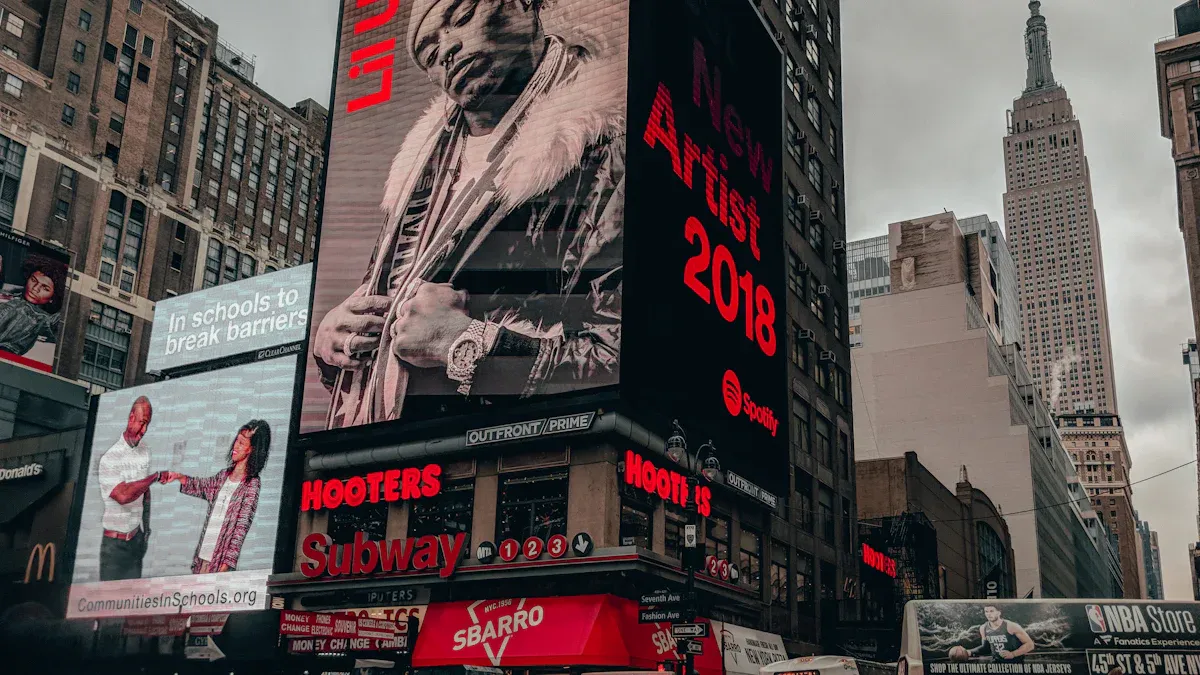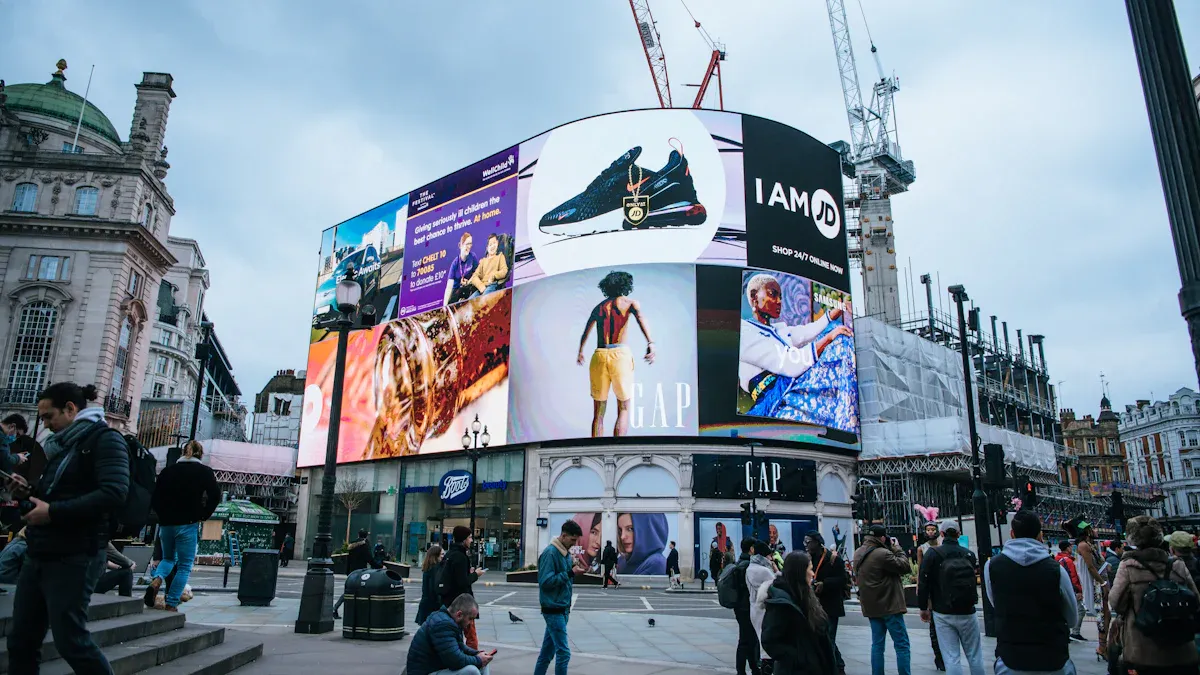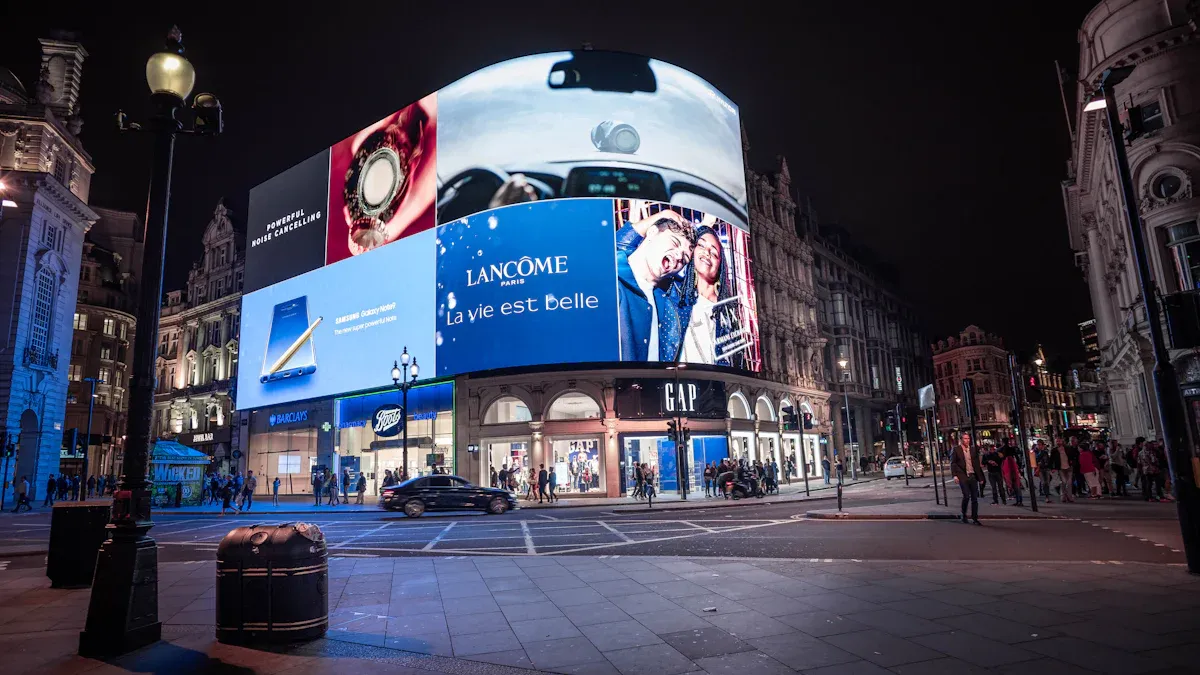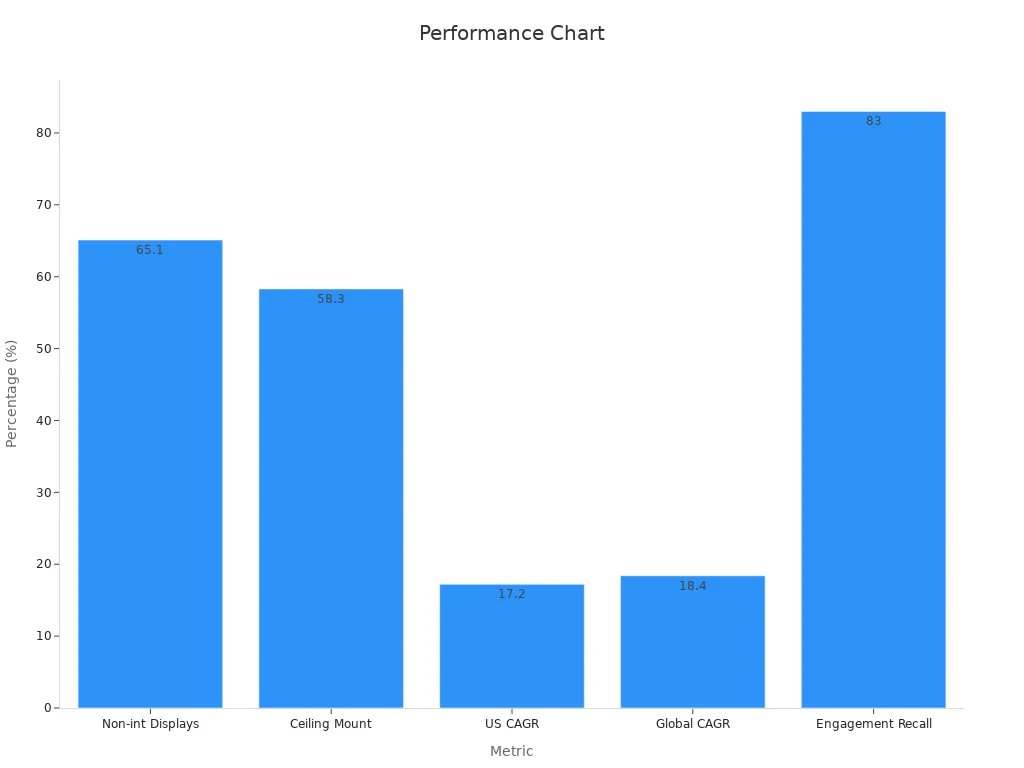Outdoor Display Signs: Types, Technologies, and Implementation Strategies

Outdoor display signs help people notice your business. These signs are found in many places. You can see them at stores and on busy streets. Some signs show pictures that do not change. Other signs use outdoor digital signage displays. These have bright screens and can handle bad weather. In stores, 68% of people trust signs more than online ads. Outdoor digital signage displays can bring in 25% more people. Digital signage displays are flexible and get 400% more views than regular signs. If you use weatherproof outdoor digital signage displays with strong brightness, your message will always be seen.
Key Takeaways
Outdoor display signs have three main types. These are static, digital, and interactive digital. Each type helps businesses in different ways.
Digital outdoor signs get more attention than static signs. They help increase sales. You can change their content quickly. This makes them more useful than static signs.
Picking the right technology is important. You can use LED or projection. Weatherproof and bright screens help your signs stay clear outside. They also last longer.
Good site checks, picking the right hardware, and careful setup help your signs reach more people. This also helps them last longer.
Regular care, safety steps, and following local rules keep your signs working well. These steps also protect your money spent on signs.
Types of Outdoor Display Signs

Outdoor display signs come in different styles. You can pick static signs, digital outdoor signs, or interactive digital outdoor signs. Each one is good for certain business needs.
Static Signs
Static signs use printed pictures or painted words. You see them as billboards, banners, window graphics, and monument signs. These signs only change if you repaint or replace them. Static signs are best for simple messages, business names, or logos.
Examples of static signs:
Roadside billboards
Storefront window graphics
Directional signs in parking lots
Monument signs at entrances
Static signs help people find your business. About 87% of shoppers say signs help them decide to enter a small business. Businesses often get 20% more walk-in customers after new signs. You can use static signs to help people remember your brand and spot your business. Many stores use these signs to bring in local shoppers.
Tip: You can see how well static signs work by checking sales before and after you put them up or by asking customers how they found you.
Outdoor Digital Signage
Outdoor digital signage uses screens to show changing messages. These digital signage displays use LED, LCD, or projection technology. You can update messages fast and show videos, animations, or live information. Outdoor digital signage displays work well in busy places where you want to get noticed.
Metric | Digital Signage | Static Signage |
|---|---|---|
Consumer attention drawn | 63% | 58% |
Recall rate | 83% | N/A |
Increase in brand awareness | 47.7% | N/A |
Boost in customer satisfaction | 46% | N/A |
Increase in sales | Up to 33% | N/A |
Perceived wait time reduction | Over 35% | N/A |
Influence on purchasing decisions near POS | Over 40% | N/A |
Distinctiveness of commercials | 58% | 33% |
Consumers persuaded to learn more | 59% | N/A |
First-time visits due to signage | 76% | N/A |
Digital outdoor signs do better than static signs in many ways. Digital signage displays get more attention and help people remember your brand. Outdoor digital signage displays also make customers happier and help sales. In stores, you can use these signs to show deals, new items, or safety tips. Outdoor digital signage displays let you change what you show for different times or events.
Benefits of outdoor digital signage displays:
Show content that changes right away
Reach more people in busy places
Measure how guests react with analytics
Save paper and printing money
Change brightness for sunlight
Outdoor digital signage displays get 400% more views than static signs. About 70% of Americans have seen a digital display in the last month. You can control many digital business signs from one place, so it is easy to grow your marketing.
Interactive Digital Outdoor Signs
Interactive digital outdoor signs make people want to join in. These digital signage displays use touchscreens, sensors, or QR codes. You can let customers look for products, get directions, or play games. Interactive features turn watchers into active users.
Key interactive features:
Touchscreen menus for looking at products
QR codes for quick deals or app downloads
Sensors that change what you see when you move
Augmented reality for cool experiences
In stores, interactive digital signage helps you reach younger shoppers. About 60% of Gen Z shoppers use stores to find new products. Interactive digital outdoor signs can make shopping more fun and personal. For example, a store chain used interactive digital signage displays to cut wait times by 35% and raise sales by 33% during deals.
Aspect | Details |
|---|---|
Company | Bouygues Telecom |
Deployment Scale | 550 stores with 1,100 digital signage players and 500 tablets |
Implementation Timeframe | 3.5 months |
Key Outcome | 29.5% increase in average purchase value |
Impact on Consumer Interaction | Better in-store digital experience, happier customers, and more engagement |
Technology Features | Central content control, real-time checks, brightness control |
You can use interactive digital outdoor signs to get feedback, help visitors, or give special deals. These digital signage displays track guest engagement by looking at how long people stay, how many walk by, and how many interact. You can change brightness and messages to fit the place and keep your message clear and fun.
Note: Interactive features help you stand out in busy places and make your guests remember you.
Technologies for Outdoor Digital Displays

Outdoor digital signage displays use new technology to help your message stand out. You must pick the best display type for your business. The main choices are LED, LCD, and projection. Each one has special things that help people see your sign and keep it working well.
LED and LCD Displays
LED displays are the most popular for digital outdoor signs. You see them on billboards, stadiums, and in cities. LED technology gives you bright screens and saves energy. These digital signage displays work in sunlight and bad weather. Full-color LED displays show bright, moving pictures that get attention. LED displays can handle hot and cold weather and last a long time. This makes them a smart pick for outdoor digital signage displays.
LCD displays show sharp pictures and nice colors. You see them in smaller digital outdoor signs, like menu boards or bus stops. LCDs need to be very bright to be seen outside. Some LCD digital signage displays can reach 2,200 nits, so people see them in sunlight. LCDs use less power than LEDs, but they can get hot in closed boxes. You need to think about brightness, heat, and power when you pick LCD digital signage displays.
Parameter | Home Appliance Devices | Industrial Devices | Military and Marine Devices | Medical Devices |
|---|---|---|---|---|
200-400 | 400-800 | 800-1500 | 500-1000 | |
Luminance (cd/m²) | 200-400 | 400-800 | 800-1500 | 500-1000 |
Contrast Ratio | 1000:1 | 1000:1 | 2000:1 | 1000:1 |
Sunlight Readability | Moderate | Good | Excellent | Good |
Pole LED displays are often used for outdoor digital signage displays. They are very bright and easy to see, even in sunlight. LCDs are better for small screens or shady spots. For big digital outdoor signs, LED displays are stronger and cost less over time.
Tip: Always check the brightness rating for outdoor digital signage displays. Real outdoor screens need at least 2,500 nits to look clear in sunlight.
Projection Technologies
Projection technology is another way to make digital outdoor signs. Projectors can show big pictures on walls or buildings. New projectors can reach 8,000 lumens, so your digital signage displays stay bright outside. Projectors are good for events, pop-up ads, or places where you cannot put a normal screen.
Performance Metric / Statistic | Value / Description |
|---|---|
Brightness | Up to 8,000 lumens (Epson PowerLite L-Series projectors) |
Maintenance-free operation time | About 30,000 hours |
Resolution | Full HD WUXGA and 4K Enhancement Technology |
Installation Flexibility | Wide lens shift, optical zoom (up to 1.7x), 360-degree mounting, geometric correction |
Market Share (Non-interactive displays) | 65.1% global share, showing they are reliable and easy to use |
Market Share (Ceiling-mounted installations) | 58.3% global share, showing they are practical and reliable |
U.S. Market Size (2024) | USD 2.58 billion |
U.S. Market CAGR | 17.2% projected growth |
Global Projection-Based Digital Signage Market | Expected to reach USD 38.7 billion by 2034 with an 18.4% CAGR |
Consumer Engagement | 83% recall rate; 80% of customers went into stores because of digital signage |
Display Visibility | Clear and bright images even outside because of new brightness and resolution |

Projection-based digital signage displays are flexible. You can move them or change the picture size. These digital outdoor signs are great for short events or creative ads. You get high visibility and people pay attention if you set them up right.
Weatherproof Outdoor Display Signs
You need weatherproof boxes to keep your outdoor digital signage displays safe. Weatherproofing helps your digital signage displays last longer by keeping out rain, dust, snow, and heat. Most weatherproof boxes use strong metal like powder-coated aluminum or stainless steel. They also have tough glass to stop damage from hits.
Weatherproof boxes have high IP ratings. IP56, IP65, and IP66 ratings mean your digital outdoor signs can handle lots of rain and dust. These weatherproof displays also stop damage from people with IK10 glass and strong locks. Your digital signage displays can work in temperatures from -30°F to 120°F. Built-in fans and heaters keep your screens working, even in very hot or cold weather.
Weatherproof boxes keep out water and dust, which break electronics.
Strong designs stop damage from people or accidents.
Tests before use check brightness, cooling, and how strong the mount is.
Note: Always pick weatherproof boxes with the right IP and IK ratings for your area. This keeps your digital signage displays working longer and saves money on fixing them.
High-Brightness and Visibility
High-brightness screens make your digital outdoor signs easy to see, even in sunlight. Outdoor digital signage displays need at least 2,500 nits to look clear. Some high brightness screens go up to 4,500 nits. Your digital signage displays work best when they stay bright for a long time.
Screen Type | Maximum Brightness (cd/m²) | Purpose for Outdoor Visibility |
|---|---|---|
High-brightness screen | Up to 4,500 | Makes sure your content looks clear and bright in sunlight |
Display Model | Typical Brightness (cd/m²) | Visibility Features |
|---|---|---|
LG 75XE3C | 3,000 | Clear in strong sunlight; easy to read with sunglasses |
Outdoor digital signage displays use special coatings to stop glare and make contrast better. Auto-brightness sensors change the screen for different light. Weatherproof boxes keep your high-brightness screens safe from heat and rain. You get strong visibility and your screens work well with these features.
Good outdoor screens use LED or advanced LCD panels. They keep your digital signage displays bright and clear, even after many months. You avoid problems like dim screens or faded colors by picking good weatherproof boxes and panels.
Tip: For the best results, pick digital signage displays with optical bonding, UV-resistant coatings, and real-world brightness test data.
Outdoor digital displays give you many ways to reach people. You get strong visibility, weatherproof safety, and high brightness screens that last. With the right technology, your digital signage displays will stand out anywhere.
Implementation Strategies
Site Assessment
First, check the area before you put up signs. Look at how much space there is and where people walk. Notice how bright or dark the spot is. Outdoor digital signage displays work best where lots of people pass by. Make sure your sign does not block paths or cause problems. Check if there are rules about sign size or where you can put it. Think about how bright the sign should be so people can see it. You want your sign to stand out but not bother drivers or cover up buildings. See if the spot gets a lot of sun, rain, or wind. Plan for signs that last and are easy to fix.
Put signs where most people will see them.
Do not pick places with too much glare or shade.
Match your sign style to your business look.
Hardware Selection
Pick hardware that fits what you need and can pay for. Outdoor digital signage displays must be bright and have weatherproof covers. They also need strong mounts to stay in place. Choose screens with at least 2,500 nits so they look clear. Get hardware with IP65 or higher to protect from weather. Think about the price for the screen, box, and setup. Commercial-grade digital signage displays last longer and save money later. Pick hardware that lets you update content fast and add interactive features.
Component | Key Feature | Benefit |
|---|---|---|
Display | High brightness | Better visibility |
Enclosure | Weatherproof, secure | Durability and safety |
Media Player | Multiple connections | Real-time content updates |
Installation Best Practices
Install outdoor digital signage displays the right way. Use strong mounts and weatherproof boxes. Point the screens so people can see them easily. Use locks and tough designs to stop theft or damage. Pick materials that do not fade in the sun. Test the screen’s brightness and touch features before you finish. Good setup helps your sign last longer and saves money.
Tip: Clean and check your signs often to keep them working well.
Content Management
Use content management systems to control your signs. Cloud systems let you change messages from anywhere. Set up messages for different times to reach more people. Use data to see which messages get the most attention. Change what you show based on weather, sales, or events. Real-time updates keep your signs interesting. Touchscreens and QR codes make people want to join in.
Use content management systems for quick changes.
Watch how people react and improve your messages.
Maintenance and Support
Plan to take care of your outdoor digital signage displays often. Clean the screens and look for any problems. Update the software when needed. Good support keeps your signs working and helps them last longer. Fix problems fast to save money. Taking care of your signs means more people see them and your business does better. Focus on making your signs last and work well for a long time.
Challenges and Solutions
Environmental Factors
Outdoor signage has to deal with tough weather. Rain, snow, wind, and sunlight can hurt your signage. Bad weather can break screens or make colors fade. Electronics might stop working if it gets too hot or cold. Cold weather can slow down screens. Dust and water can get inside and break things. You should use weatherproof enclosures to keep your signage safe. Pick materials that do not rust or fade in the sun. Clean your signage often and check for problems. Fans and heaters help your signage work in any season. Special coatings protect your signage from damage.
Vandalism and Security
Vandalism is a big problem for outdoor signage. People might break screens or spray graffiti on them. Some may even try to steal parts. This can cost a lot of money to fix. Your signage might stop working if it gets damaged. Use strong materials and secure mounts to protect your signage. Good lighting scares away vandals at night. Motion lights turn on when someone comes close. Security cameras help you watch your signage all the time. Fences and gates make it harder for people to get close. Alarms warn you if someone tries to break your signage. Security patrols can check your signage often. Warning signs tell people you are watching and protecting your signage.
Regulatory Compliance
You have to follow rules when you put up outdoor signage. Laws say how big your signage can be and where it can go. Some places do not allow flashing signage to keep drivers safe. You need permits before you install signage. ADA rules help everyone use your signage, even people with disabilities. Many places want your signage to be safe and good for the environment. Always check with local offices before you start. Use certified products and follow the rules to avoid fines. Following guidelines keeps your signage legal and safe.
Budget Considerations
Planning your budget for signage is important. The price can be from $5,000 to $200,000, depending on what you need. Renting signage space costs $1,200 to $15,000 each month. Think about labor, materials, equipment, and maintenance. Digital signage saves money because you can change messages fast. You do not need to print new signs every time. One screen can show many messages and save space. Use cost control tools and check your budget often. Stakeholders must agree on big spending. Update your budget as your project changes.
Aspect | Details |
|---|---|
Analogous, Parametric, Three-Point Estimating | |
Budget Components | Labor, Materials, Equipment, Services, Travel, Facilities, Risk reserves |
Budget Approval Process | Stakeholder sign-off required |
Cost Control Techniques | Change control, Earned Value Management, Cost forecasting |
Cost Monitoring Tools | Software, audits, reports, cost databases |
Tip: Digital signage helps you change messages quickly and reach more people without paying for new prints.
You have many options when choosing outdoor display signs. You learned about static and digital signage, the latest display technologies, and smart ways to set up your signage. Weatherproofing, high visibility, and following rules help your signage last and work well. Start by looking at your needs. Talk to a signage expert or plan a site check to get the best results.
FAQ
What are the main types of outdoor display signs?
There are three main types of outdoor display signs. You can pick static signs, outdoor digital signage, or interactive digital signage. Each type is good for different uses. Digital outdoor signs let you change messages fast. They have bright screens that are easy to see. Interactive features help people join in and pay more attention.
How do weatherproof enclosures protect outdoor digital displays?
Weatherproof enclosures keep rain, dust, and heat away from your screens. These displays use strong materials and tight seals. This makes them last longer outside. Weatherproofing helps your screens work well for many years.
Why is brightness important for outdoor digital signage displays?
Brightness makes your sign easy to see in sunlight. High brightness displays help your message stand out. You need bright screens so people can read them outside. Good brightness helps more people notice your sign.
How can you manage content on digital business signs?
You can use content management systems to update your signs. These systems let you plan messages for different times. You can change what shows for special events. This keeps your signs new and interesting.
What factors affect digital signage costs in retail?
The cost of digital signage depends on a few things. Screen size, weatherproof features, and interactivity all matter. Installation can also change the price. Bright screens and interactive signs may cost more. Good planning helps your signs last and saves money later.
See Also
Exploring LED Sign Types And Effective Implementation Methods
Understanding Digital Signage Technology And Its Key Advantages
Indoor Versus Outdoor Digital LED Signage Display Comparisons

